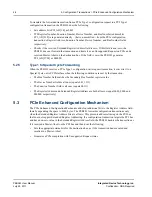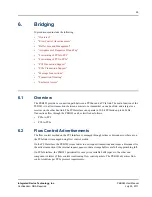
43
PEB383 User Manual
July 25, 2011
Integrated Device Technology, Inc.
Confidential - NDA Required
5. Configuration
Transactions
Topics discussed include the following:
•
•
•
“PCIe Enhanced Configuration Mechanism”
•
“Configuration Retry Mechanisms”
5.1
Overview
Each device in a PCIe or PCI system has a configuration space that is accessed using configuration
transactions in order to define its operational characteristics. This chapter describes how the PEB383
handles PCIe configuration requests.
5.2
Configuration Transactions
There are two types of configuration transactions: Type 0 and Type 1. Type 0 configuration
transactions access the PEB383’s internal configuration registers, while Type 1 configuration
transactions access devices that reside downstream of the PEB383. Type 1 transactions are converted to
Type 0 transactions if they target devices that reside on the downstream PEB383 bus. If the transaction
is intended for a device that is downstream of the bus directly below the PEB383, the transaction is
passed through the PEB383 as a Type 1 configuration transaction. If the transaction is not targeted for
the PEB383 or any device below the PEB383, the transaction is rejected. Configuration transactions
are only initiated by the Root Complex in PCIe-based systems.
Configuration address formats are as follows.
Figure 14: PCIe Configuration Address Format
Reserved
Register
Address
Extended
Register
Address
Reserved
Function
Number
Device
Number
Bus
Number
1 0
7 2
11 8
15 12
18 16
23 19
31 24
Reserved
Register
Address
Extended
Register
Address
Reserved
Function
Number
Device
Number
Bus
Number
1 0
7 2
11 8
15 12
18 16
23 19
31 24
















































